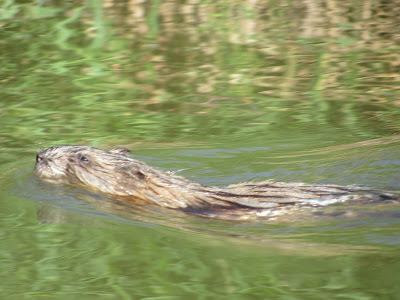This morning I decided to head out to Lake Alvin for an
early morning paddle. We have been
through a long string of sweltering days here in the Sioux Falls area, so an
early start seemed essential. I
have not been on Lake Alvin since late April and looked forward to seeing the
transformation from spring to full summer.
I arrived at the public access point on the southwestern
shore about 9:00 a.m.
The sky was
clear, the temperature about 80 degrees, and there was a brisk wind coming out
of the south.
As usual, I paddled across the lake and began my trip south
into Nine Mile Creek.
When
approaching the southern end of the lake and the entrance into the creek, it is
critical to keep to the left (east) side of the shoreline to pass over the
silted bar of mud and sand that comes down the creek into the lake.
I continued south into the creek and easily passed under the
bridge and into the narrow stream than flows south. There are a number of curves in the stream, and the channel
tends to move from one side to another.
A paddler has to keep examining the flow and be ready to scoot over to
the appropriate side as dictated by the bottom. In the channel, the water depth is generally two to three
feet and is generally a few feet wide.
The creek is where I most often come across wildlife,
including beaver and waterfowl.
Today, a great blue heron kept ahead of me; it would rise out of the
bush upon my approach and move upstream until I approached again.
After paddling upstream, I lowered my rudder and coasted
down the current to the mouth of the creek.
I guess that the distance on the creek portion of the cruise
was about 3 miles roundtrip.
Even though the lake itself was a bit choppy from the brisk
south wind, the creek was tranquil.
The bank and towering plant life provides a windbreak of about 8 feet,
so the creek is nicely protected.
After exiting Nine Mile Creek, I decided to explore the
waters on the southeastern end of the lake.
Because of the shallow conditions and muddy bottom, I
normally avoid that portion of the lake. I cruised over to the side and found
myself fascinated by the many schools of small black fish.
Looking over the surface of the water, these schools looked
like shadows on the water that moved about.
Some of the schools were several feet in length and
seemingly contained hundreds of fish.
They would approach my kayak and surface for a moment in a sparkling
display as they came to the surface for a moment.
These schools would move about that section of the lake,
forming into various shapes.
At
any one time, I could see six or eight groupings.
My attention was riveted on these fish for a few moments.
After passing through the fish, I continued moving north and
passed groups of carp swimming generally in the direction of the fish
schools.
I wondered if the carp
were headed for a meal of small fish!
Heading north on the main body of Lake Alvin, I was
traveling with the wind, and little paddling effort was needed.
As often occurs on a windy lake
surface, the waves were sometimes outpacing my kayak, creating a following sea
condition.
I continued north until I was across from the recreation
area launching site, about two-thirds of the way up the lake.
From there, I turned and headed into
the wind for my return trip to the southeastern access area.
The wind created a healthy chop in the water, and I moved
over to the western shore to make my way back.
When waves develop on a lake, I feel safer paddling close to
the shore.
In the wind, I resorted to my old paddling instruction in
which I learned that it is the push of the arm that translates into power
rather than pulling.
And, as
normal in these conditions, I made my way from one landmark along the shore to
another and counted my strokes.
Today, I spent about 90 minutes on the water and didn’t see
anyone, either on the water or on the shore. It was totally a solo experience.
For the past three weeks, I have been serving as a paddling
volunteer at the Outdoor Campus in Sioux Falls.
Last Tuesday, I performed this service at the pond behind
the Outdoor Campus complex and worked with two people who had limited
experience in paddling.
For
further information of paddling opportunities available through the Outdoor
Campus, check out the heading in the menu on the right side of the blog.

















No comments:
Post a Comment